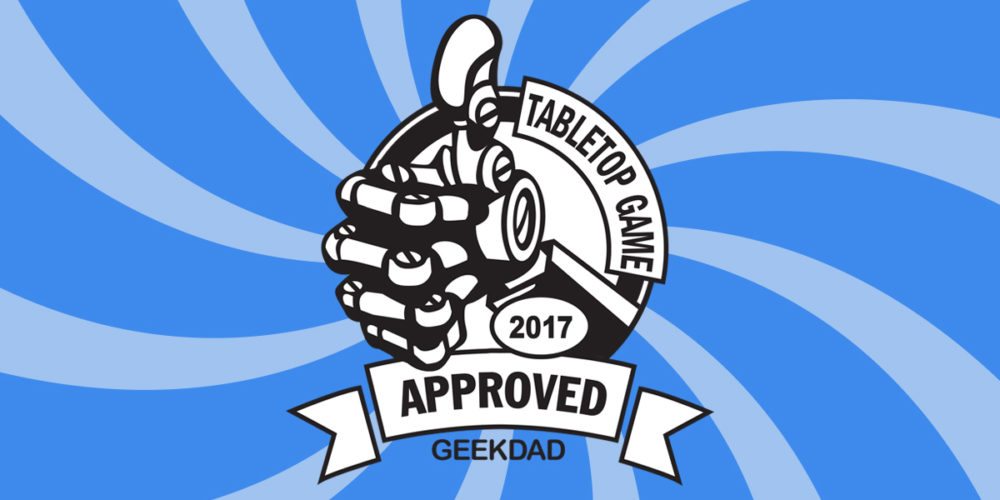Prologue: What Is Ex Libris?
In an (unnamed) fantasy town, you and your competitors are purveyors of fine and valuable books. What a grand place that can support 1-4 very unique book stores! In this village, the mayor has just announced a new position, which carries with it a seat on the Village Council, that of Grand Librarian. It’s a lucrative position, but one you will all be vying for in this 1-4 player game for ages 10 and up that plays in about 45 minutes. Who will be the winner? Find out in Ex Libris!
Table of Contents: Ex Libris Components
Usually, I would start by telling you want’s inside the box, but this time, let’s begin with the box itself. Functionally, there’s nothing unusual about it, it’s your usual 12″ x 12″ square and is about 3.5″ deep. What’s neat is when you look at its edges, you realize the art was made to look like a thick tome, casebound and home to dozens of signatures, some leafs spilling from its borders, the volume having been so well read. It’s the type of book a wizard would pull from his shelf before casting a powerful incantation. It’s neat and it’s fun — it’s also a good example of the special attention to detail that you see in so many of Renegade’s games that makes me like them so much.
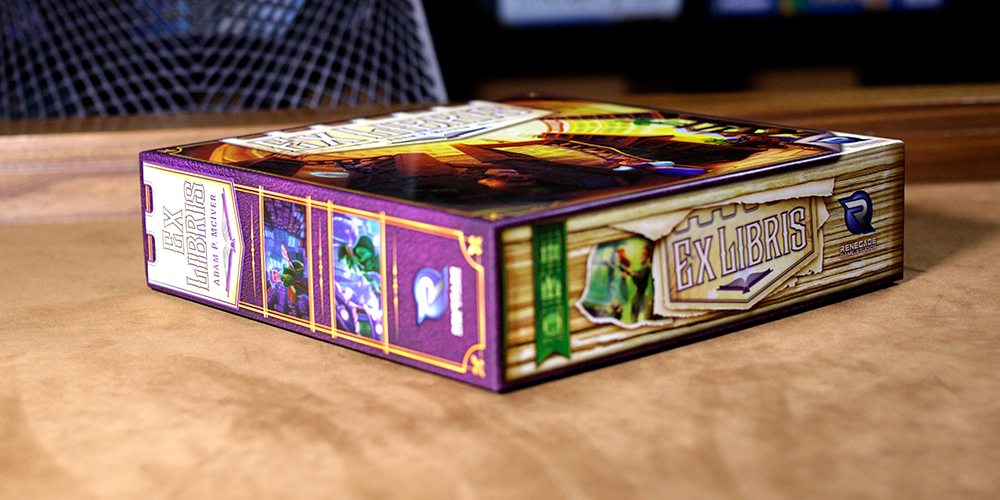
So, with that out of the way, inside the box, you’ll find:
- 152 Book Cards
- 6 Category Cards
- 12 Library Tiles
- 17 Location Tiles
- 12 Special Assistant Tokens
- 1 First Player Token
- 12 Standard Assistants in (3 each in 4 colors)
- 1 Game Board
- 1 Double-Sided Dry Erase Board
- 1 Dry Erase Marker
Any discussion about Ex Libris has to begin with its book cards. They’re just a bit smaller than standard bridge sized cards and, on their playing sides, made to look like books on a shelf. The bottom and top of the cards are bordered with wooden shelves and sitting on each shelf is a number of books. Some cards have more than others, but all cards have important information on them.
Seemingly hanging from the top of each shelf card is a small banner with the following data points: the card’s letter, followed by a fractional number. For instance, a card that reads “F 4/6” means all books on that card begin with the letter F. Further, the fraction denotes that there are six cards in the “F” family and this is the fourth one. Next to the banner are a number of symbols representing the categories of books on that shelf.

The books themselves are illustrated nicely and all books within a category are illustrated in much the same way. Fantastical Fictions are all bound in green leather with gold leaf for the title and flourishes. Reference Texts are done in blue binding and white text — and so on.
But where the cards really shine is when you start reading their titles: Everything Is Bad If You Dig Deep Enough, Actually … The History of Humansplaining, Diabolical Body Follicles, Examples of Egg Samples, Bugbears: Neither Bugs Nor Bears, The Hardly Boys. There’s even The Official Ex Libris Strategy Guide. There are hundreds of these book titles and most of them will at least bring a smile to your face if not cause an outright snicker. Possibly, even a guffaw.
The cardboard for the tiles and boards is all nice and thick. The tiles are of a decnt size, about the length & width of a modern smart phone. The game board, on the other hand, is an unusual size. At 28 inches wide and only a quarter of that tall, it makes for a very narrow board. That’s OK, table space ends up being at a premium when you begin your game.
The library tiles have two sides to them, one for a basic game, which includes instruction for basic moves and a grid that shows numerical distribution of the book cards by letter. On their opposite side is an advanced side with a themed library title and adds a place for your library’s focus, and a home for a special assistant who carries a special power. Believe me, you want to play on the advanced side every time. The location tiles are single sided and provide a place for your assistants, or workers to go. Each is capped to a limited number of visitors and each provides an ability.

One of my few complaints about this game is found on these tiles. The abilities of special assistants and locations takes a fair amount of words to describe and that description is done with light colored text against (oftentimes) a multi-colored background. Given that these tiles are in the center of the table, it’s pretty difficult to read them. There is an explanation of each in the rule book, but that’s tough to pass around. After a few plays, everyone will know what the cards do, but it’s a small challenge at first. I wish there were player aids or something to speed up those initial games and help to serve as a reminder later.
The standard assistants are shaped like gnomes and fit the fantasy theme. The 12 other special assistants are all uniquely shaped (and colored) wooden tokens — an incredible variety for a game like this. There’s a ghost, a fire imp, and a sasquatch. They sit alongside a golem, goblin, and even a gelatinous cube — and that’s only half of them. They are fantastic!
Sadly, after all these great components, the white half-domed first player token feels like an afterthought. It would have been really perfect to have a book or a bookmark or library card or something more on theme, but that’s OK because everything else is very nice — not to mention how the game plays …
Ex Libris is GeekDad Approved!
How to Play Ex Libris
There is a solo mode, but I’ve not played it so won’t address it in the setup, gameplay, or scoring. If you’re interested in that, I suggest looking at the rule book, pp.19-21. Additionally, there is a first game setup and rules for beginner play, but we will only be looking at the setup and rules for a regular game.
To begin the game, put out library tiles and corresponding assistant tokens equal to two times the number of players. After deciding who will be first, the players, in turn from the last player to the first player, pick a library tile and its corresponding token and then they select a paired library tile and token to discard. Players pick a standard assistant color and get two of those tokens.
Category cards are shuffled and two are selected to be placed on the main playing board — one for Prominent Works, one for Banned Books. More on these in just a moment. Each player then gets a category card, which they keep secret. Any extra category cards are placed in the box without looking at them. After shuffling the book cards, each player is dealt six. One location tile, the Diviner’s Hut is placed in the center of play and you are now ready to begin play.
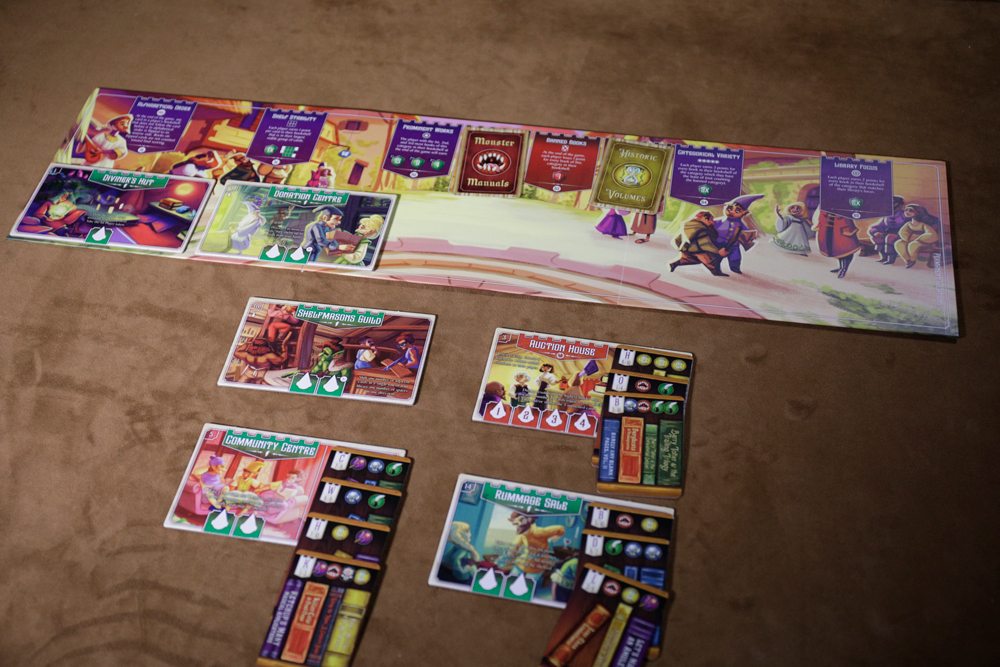
To play, first, you must understand how to score points in Ex Libris. All scoring in the game is generated from how you build your library and the first requirement is that all your books be placed in a grid in alphabetical order, from left to right and no higher than three rows tall. After placing your first card, every subsequent card must be placed orthogonally and touching an existing book card in your library. Additionally, cards must adhere to the numerical order rule. That is, as mentioned above, if there are seven cards featuring the letter “E” as the beginning letter and you have more than one, they must appear in numerical order, as well (i.e. 2/7, 5/7, 6/7). If at the conclusion of the game, any cards are out of order, cards in violation must be flipped to make an alphabetical order complete.
Next, beginning with the lowest row, players find the largest rectangle in their library. This might be a grid that’s 3 x 3, 4 x 2, or some other configuration. A stable library is important so that citizens might look at your books safely, without fear of books toppling on them and you will earn a point for each card in your largest rectangle.
The Prominent Works, as dictated by the category card on the main board is the type of book that the town most wants to see. Whoever has the most will earn 15 points, second-most gets 9, and third most scores 4. Banned Books, on the other hand, are dangerous to your town and you will lose one point for every book from this category in your library.

The town is diverse, so you’ll want to carry enough of a variety to cater to everyone’s tastes. At the end of the game, all categories are tallied and you will earn 3 points for each book representing the smallest category in your collection (not including Banned Books). Finally, at the game’s end, you will reveal your library’s focus, the hidden category card you’ve secreted away. For each book matching this category, you’ll get 2 points.
Now that you know how to score, let’s look at a round of gameplay. You’ve already set out the Diviner’s Hut for the first round, but before play starts, you’ll place a number of random location tiles so that all location tiles on the table are equal to the number of players. Some might ask you to place Book cards on them, which you’ll do before proceeding with play.
Players then take turn placing their assistants on location tiles or their own library tiles. Location tiles offer a wide number of benefits, everything from discarding cards from your hand to acquiring face up cards from the main play area. There are even effects that may cause other players to lose a card from their hand. No two location tiles are alike and each requires a strategy for using the tile.
When visiting your own library, a player can simply draw a Book card from the draw deck or shelf a card from your hand. If you still have your special assistant this round, each library has a special power that only that assistant can use. Some special assistants let you move your already shelved cards in your library, others give you extra actions, or prevent others from taking actions at locations. With a dozen libraries, the powers are all pretty varied and the powers seem pretty well balanced. Choosing which one to call your own can be a tough decision.

Most effects are immediate, though there are some that resolve at the end of the round. After all assistants have been placed and all effects resolved, Players check to see if anyone has met the end game condition — a set number of cards shelved in their library. That number adjusts, depending on the number of players in the game. If that condition has not been met, assistants are retrieved, the location tiles are considered and the tile with the lowest identifier number on it is moved to the main board, providing players with an expanding number of choices to visit as the game moves on. Old location tiles and any Book cards are moved to a discard area and players are ready to begin the next round, by again setting out location cards equal to the number of players.
Should a player meet the end game condition, the game ends and scoring is tabulated on the dry erase board. The player with the most points wins and is crowned Grand Librarian.
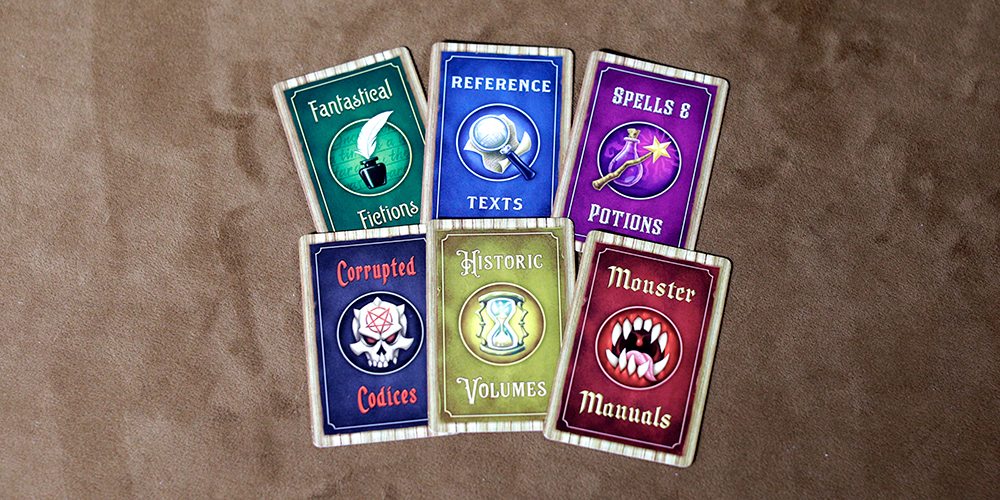
Epilogue: Why You Should Play Ex Libris
Ex Libris is one of those games that is pretty easy to learn and seemingly simple in its rule set. However, once you get a couple of turns into your first game, you realize there’s ample opportunity for strategy and plenty of options for play right at your fingertips.
Beginning with the choice of library tiles, you will start your plan toward winning. The one you choose is important, but so is the choice about which library tile you discard because you’re also taking away a choice from your competitors. Each turn, the location tiles will be replaced and you had best take advantage of opportunity when it presents itself — before competitors block you out or the location tile goes away.
Both library and location tiles are balanced really well and include some great powers and opportunities and you will genuinely agonize over which to choose. All of these decisions can lead to some game slowdown, but really only during the first game or two. The more familiar you are with tiles, the faster the game plays.
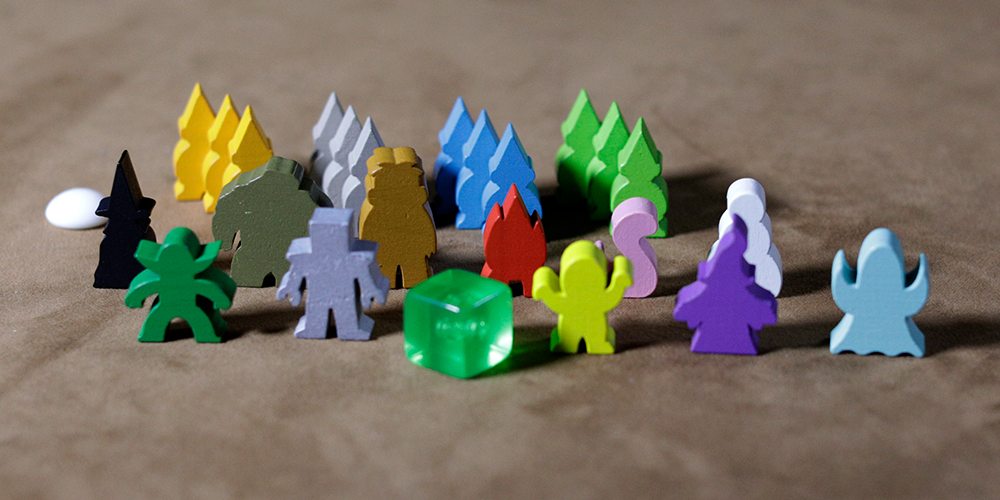
When shelving book cards, a plan is important. Because of the rules for placement, the ideal card does you no good if you’re not ready to immediately place it. So all of a sudden the plan for that round may be thrown out the window as you make a new plan to get that ideal card. Like a good merchant, you have to react to market conditions. Or perhaps that ideal card should be passed on, maybe it isn’t ideal. Surely something equally good will be available at a later turn or round. Won’t it? Not always. These are just a couple of the risks and decisions you’ll have to make on your quest to become Grand Librarian.
Worker placement is a mechanic that has been around for a long time and it’s becoming more and more difficult to find a new take on that style of play that makes me want to add another worker placement to my game library (or replace an existing game). Ex Libris manages to bring enough new elements to the table to earn a spot on my shelves. (No pun intended.) The ever-rotating locations, the choices of specialists, and the puzzle of shelving book cards all combine to form a great take on an old mechanism.
Thanks to the large number of library tiles and book cards, Ex Libris has high replayability and, thanks to the variety of powers, you’ll want to try them all before deciding on a favorite. The huge assortment of tokens representing each of the specialists for the libraries is an amazing inclusion and are wonderful complements to the beautiful artwork. Not only is Ex Libris a very enjoyable game with a wonderful theme, the hundreds of hilarious book titles will keep you engaged for game after game after game.
Ex Libris releases this week from Renegade Games and retails for $60.
Click here to see all our tabletop game reviews.
If you’d like to stay up-to-date with all of our tabletop gaming coverage, please copy this link and add it to your RSS reader.

Disclosure: GeekDad received a copy of this game for review purposes.



